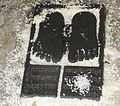| Aranatha | |
|---|---|
 | |
| Venerated in | Jainism |
| Predecessor | Kunthunatha |
| Successor | Mallinatha |
| Symbol | Fish [1] |
| Height | 30 bows (90 metres) |
| Age | 84,000+ |
| Color | Golden |
| Genealogy | |
| Born | |
| Died | |
| Parents |
|
| Dynasty | Kuruvaṁśa—Ikṣvākuvaṁśa |
| Part of a series on |
| Jainism |
|---|
 |
Aranath(Arnath) was the eighteenth Jain Tirthankar of the present half cycle of time (Avasarpini). [2] He was also the eighth Chakravartin [3] and thirteenth Kamadeva. According to Jain beliefs, he was born around 16,585,000 BCE. He became a siddha i.e. a liberated soul which has destroyed all of its karmas. Aranath was born to King Sudarshana and Queen Devi (Mitra) at Hastinapur in the Ikshvaku dynasty. [2] His birth date was the tenth day of the Migsar Krishna month of the Indian calendar.



